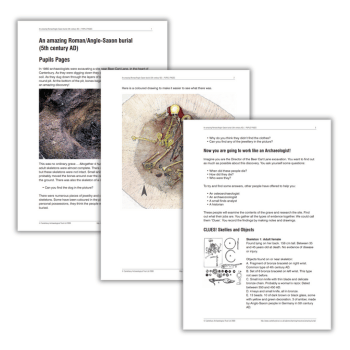Download this free archaeology KS2 resource pack and give your chance to solve the puzzle of a mysterious burial site in Canterbury.
In 1980 archaeologists were excavating a site in the heart of Canterbury. As they were digging down they came to a thick layer of dark brown soil. As they dug down through the layers of soil, they began to uncover a large round pit.
At the bottom of the pit, bones began to appear. It was the beginning of an amazing discovery. To this day, no one has solved the mystery.
With this archaeology KS2 resource, pupils will imagine they are the director of the excavation. Who can come up with the most convincing interpretation about what happened here 1500 years ago?
We will probably never know for sure. But it’s fun and stimulating trying to find out – and children will come up with a number of theories!
The burial and its location
The grave was found in 1980 by Canterbury Archaeological Trust. Experts are confident that the burial was made around the 5th century AD.
To this day, we cannot say with any certainty who these people were and what happened to bring about their deaths and we will probably never know. This sense of mystery makes the whole discovery very appealing.
National curriculum applications
At KS2 you can use this resource during work on the Romans, Anglo-Saxons or Vikings in Britain, or in a local area study.
Use the material to help develop skills while using a range of sources: observation, identification, interpretation, recording and communicating ideas and results.
Across the curriculum
You could bring in elements of other subjects, for example geography (location of site), science (the human body, survival and decay of materials) and English.
English activities
This burial is an image which can fire children’s imaginations. Use it to encourage them to express their ideas both verbally and in writing.
In working out their theories they will need to order their work in a systematic way, record various types of data and then present their results. New vocabulary and descriptive work will come as part of the process.
It is important that children realise there is no ‘correct answer’ to this mystery. They may well come up with several valid interpretations for what happened.
Canterbury Archaeological Trust was formed in 1976 to undertake excavations, research, publication and the presentation of the results of its work to the public.











